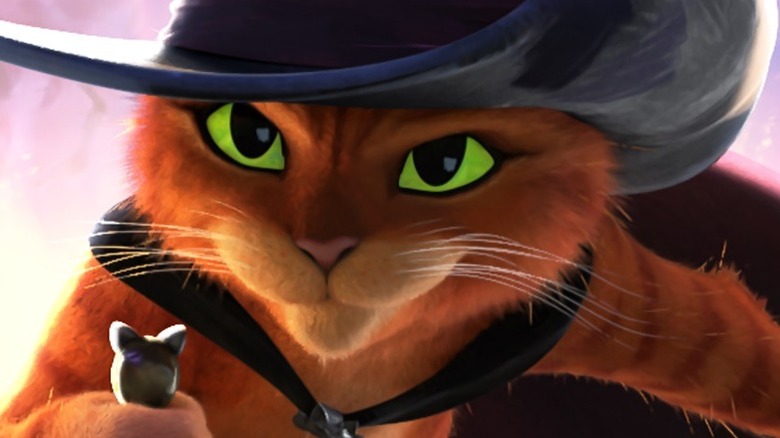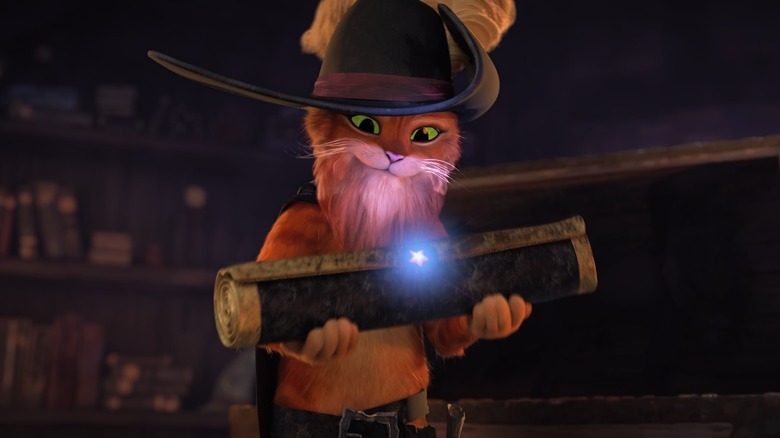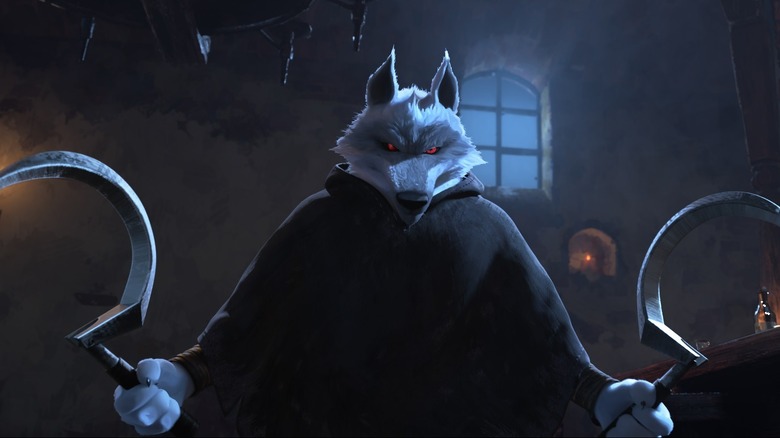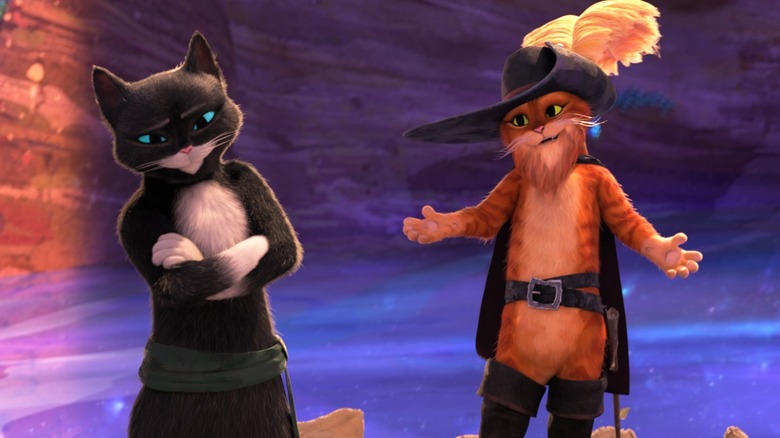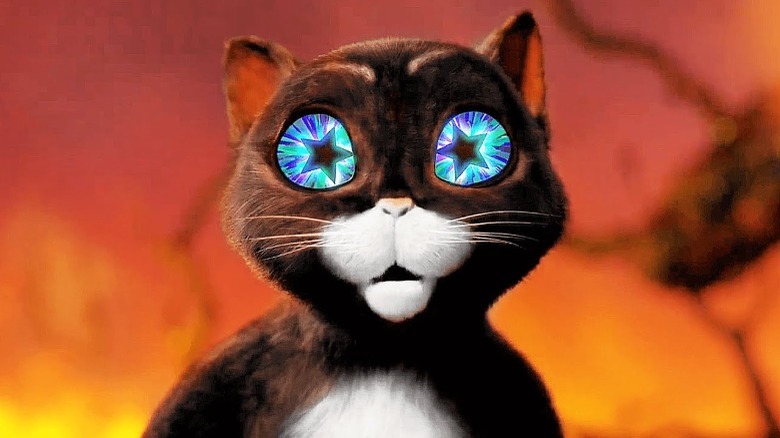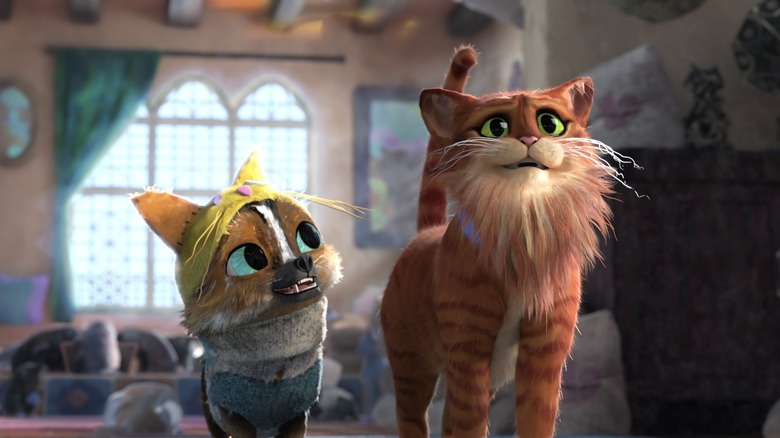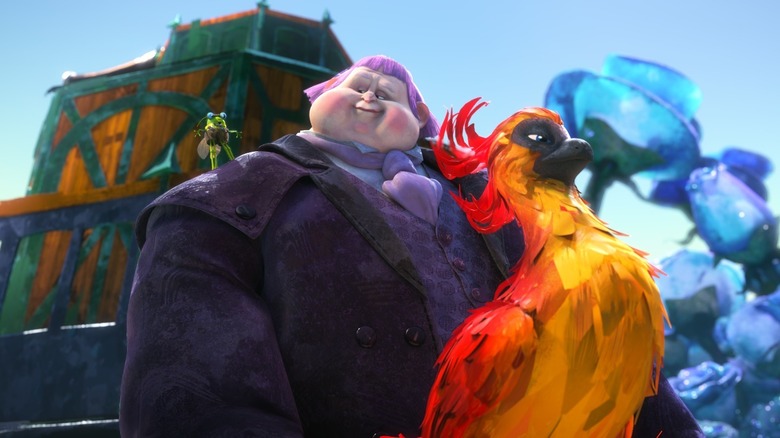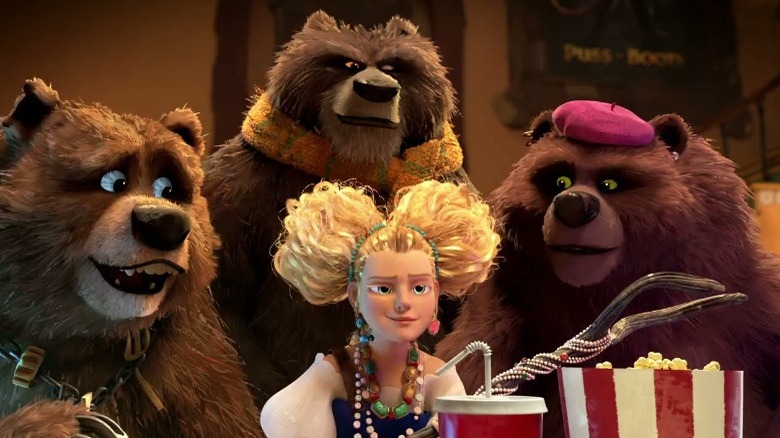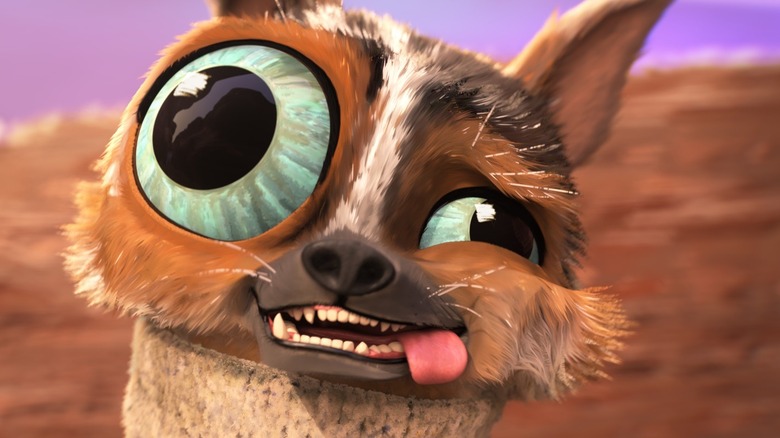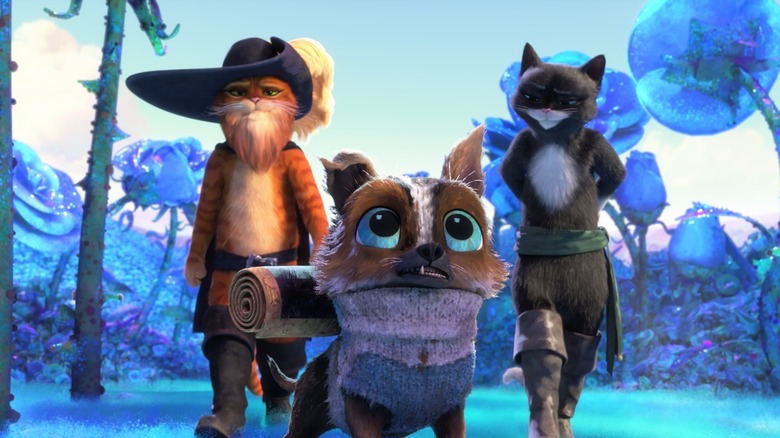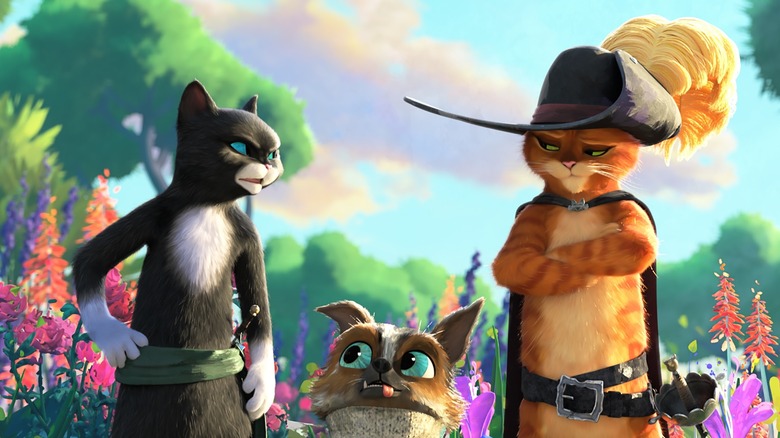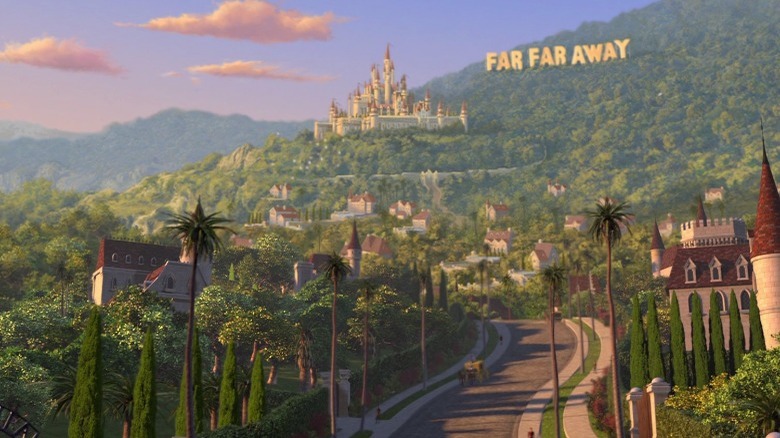The Ending Of Puss In Boots: The Last Wish Explained
One of the most welcome additions to the sprawling "Shrek" universe of the 2000s, Puss in Boots, livened up the franchise with some delightful comic relief. Based on a popular fairy tale that originated in Italy, Dreamworks Animation's Puss in Boots was designed to emulate the swashbuckling flair and Spanish origins of actor Antonio Banderas's role in 1998's "The Mask of Zorro." After a standalone "Puss in Boots" movie in 2011 and six seasons of a Netflix prequel show (in which the character is voiced by Eric Bauza), Banderas has returned with many other familiar voices for perhaps the final bow of the character in "Puss in Boots: The Last Wish."
The film tells a surprisingly deep story about mortality and fulfillment and has its share of inside jokes and Easter eggs, but it's a long way from the reference-packed humor of the original "Shrek" and its sequels. Down to the last of his nine lives, Puss is having an identity crisis and must search for a fallen star to grant his wish of getting his lives back. Along the way, he confronts lost love, death, and even sorts out the long-simmering issues between cats and dogs. Let's separate the fairy tales from the plot devices and make sense of an unexpectedly complex family film. This is the ending of "Puss in Boots: The Final Wish" explained.
No wish necessary
The title of "Puss in Boots: The Last Wish" continues an elegant bait and switch. The whole movie centers on Puss' attempts to use a magical map to find a fallen, wish-granting star, which he intends to use to wish for his nine lives back (or the other eight of them, anyway). But by the time he gets there, much like Dorothy and the gang in "The Wizard of Oz," Puss and the majority of his friends and adversaries realize that the thing they are wishing for has been with them all along. But while that could easily be as cheesy as it sounds, it's earned for each character and satisfying in its effect.
For Puss, this means realizing that mortality and death are what give life meaning, and he embraces his remaining time and understands he doesn't need to be alone. Kitty Softpaws (Salma Hayek) finally has someone she can trust as a result, and even Goldilocks (Florence Pugh), who wishes for a real family, realizes that the Three Bears who took her in are her family already. It's only the villain, Big Jack Horner (John Mulaney), that still wants to wish for more magical power, and he pays the price for his greed when the map gets destroyed and the fallen star blasts back into space.
The showdown with Death
Death comes for us all, as they say, and in "The Last Wish" it comes for Puss in the form of a big, bad wolf. Instantly joining the ranks of the best grim reapers in pop culture, Wagner Moura's role as the wolf that turns out to be Death adds gravity and immediacy to the movie. He even makes it eminently clear that it's not an allegory whatsoever: "And I don't mean it metaphorically or rhetorically or poetically or theoretically or any other fancy way. I'm Death straight up!"
Puss' fear when one of Death's scythes draws blood — when no blade had ever touched him before — causes him to abandon his identity and flee in terror as Death stalks him on the path to the star. That makes it ultimately all the more satisfying when Puss stands up to Death at the end and fights him to a standstill. In contrast to his careless, reckless eight other deaths (highlights from the montage include falling from a rooftop while inebriated on milk or trying to bench press too much weight), Puss is willing to die a noble, heroic death that puts all his vain former selves to shame. Disappointed to find his target no longer arrogant and prideful, Death backs off and leaves Puss to live out the rest of his last life in peace.
What happened at Santa Colomba?
"The Last Wish" sees our hero reunite with his love interest from "Puss in Boots," Kitty Softpaws. It also brings Antonio Banderas back together with co-star Salma Hayek; the duo has worked together multiple times dating back to Hayek's breakout role in 1995's "Desperado." But in between movies the romance between Puss and Kitty has run its course. They're initially surprised to both be chasing the same fallen star, and Kitty makes multiple angry references to "what happened at Santa Colomba."
As Puss eventually reveals to Perrito (Harvey Guillén), the pair were set to be married in Santa Colomba some years past, but he got cold feet and never went into the church. But there's a twist: it was actually a mutual ghosting, as Kitty didn't show up either. She suspected, accurately at the time, that she would never be able to compete with the love Puss had for himself and his own legend. After he's clearly matured by the events of "The Last Wish," their feline romance is renewed.
The map reveals your path
The fallen star, the enchanted map, and the Black Forest all seem to work in tandem to reveal things about the characters questing for the all-important wish. The entire landscape of the Black Forest can transform all at once, whenever someone new looks at the map. At first, it seems kind of like just different random fairy tale obstacles, but as more characters get ahold of the map, you realize there's a logic to it. The map and the forest are presented to each character with a symbolic representation of their internal mental landscape.
Basically, it creates a different obstacle course of the things they need to work through (like a strange combination of "Double Dare" and immersion therapy). Puss is afraid of death, and the forest becomes a fiery landscape of oblivion. Kitty Softpaws wants someone she can trust, so it becomes a bleak and lonely swamp. Goldilocks wants a "proper" family, and the forest and map know exactly how to weaken her resolve: by recreating the Three Bears' cabin and reminding her of the family she's already got. Perrito, as the character with the most open heart and no psychological baggage, has a path of relaxation and flower-smelling, signaling his general even-keel mentality.
What's in a name?
Names are a significant running theme in "The Last Wish." First, Puss gives up his name, along with his titular boots, his belt, and his hat. After being cowed by the Wolf and losing his sword, he abandons his identity and goes to live in a cat sanctuary under the new name, Pickles. After eight cat lifetimes of riding the momentum of his name and his own legend, he resigns himself to anonymity among a household of hundreds of cats that apparently can't talk.
But just when he sheds his identity in a moment of panic and retreat, he meets a nameless dog masquerading as a cat. The dog is too innocent and optimistic to realize that his previous owners attempted to drown him, and his boundless enthusiasm does nothing but annoy Puss at first. But little by little, by the virtue of his loyalty and mindful attitude, he endears himself to Pickles and chooses his own name, Perrito. It's ultimately as simple and form-to-function as the name, Puss in Boots.
What a good boy am I
The villain of "The Last Wish," Big Jack Horner, has come a long way from his "little" beginnings. Now in charge of a lucrative pie empire, he's on a quest to possess every magical fairy tale artifact that he can get his hands on — he's also committed to a terrible haircut in an homage to Lord Farquaad. Many magical objects, a la the One Ring from "Lord of the Rings," eventually take over the owner, and Big Jack Horner is corrupted on all sides.
We only get a small glimpse of his backstory. Perhaps acknowledging that his origins are from the briefest of nursery rhymes, Jack is shown as a child entertainer having his thumb-plum routing thoroughly upstaged by Pinocchio (Cody Cameron) the living puppet. When one of his magical artifacts contains an Ethical Bug (Kevin McCann, doing a pretty good Jimmy Stewart), it seems like the new companion might help Jack see the error of his ways, just as the Talking Cricket helps Pinocchio learn in most versions of the story. But as Jack callously shoots his own servants trying to get the map, the Ethical Bug realizes his irredeemability and burns the last piece of the map, preventing Jack from reassembling it.
This family's just right
In addition to Puss' emotional arc of learning to make room for others in his life, "The Last Wish" creates a compelling story for Goldilocks and the Three Bears in just a few scenes. Goldilocks, in this version of the fairy tale, is apparently an orphan, or at least so young that when the bears discover her sleeping in Baby Bear's (Samson Kayo) bed, they decide to keep her and raise her as their own instead of menacingly chasing her away. When we meet them in "The Last Wish" they've been operating for some time as a criminal enterprise.
It is in fact Goldilocks and the bears that have intel about the map being delivered to Jack Horner, and they hatch the plan to try and hire Kitty or Puss to steal it for them, before attempting it themselves. The foursome works together so well, in fact, it's kind of an emotional gut-punch when it's revealed that Goldilocks wants to use the fallen star to wish for a "proper," presumably human, family. As Papa and Mama Bear, Ray Winstone and Olivia Coleman do outstanding work by heart-breakingly deciding to help Goldilocks find the star anyway. Far from the children's story, which is mostly based on the tension that Goldilocks will be eaten, "The Last Wish" turns the bears into a bumbling but kind-hearted crime family that knows the meaning of sacrifice, if not the meaning of subtlety or restraint.
The power of big eyes
"The Last Wish" pays off a long-running gag about how adorable cats can look, and even manages to make it crucial to the plot. In the first scene when the ragtag team of Puss, Kitty, and Perrito are bonding on the road, Kitty and Puss essentially have a "cute off" and see who can make the more adorably huge-eyed, pleading, and begging look to get what they want. Perrito tries to do it as well and nearly pops his eyes out of his head from the straining. It's a trademark Puss move, one he was perfecting decades before Baby Yoda got in the adorable giant eye game.
It's a funny scene, and you forget all about it until a key moment during the final battle with Big Jack Horner. In the spur of the moment, Perrito distracts the villain by finally mastering the big eye technique, giving Puss, Kitty, and Goldilocks enough time to rip up the map and end the threat entirely. When all else fails, dilating your pupils to an absurd width and holding your paws near your chin is a failsafe maneuver, if only as a distraction.
Stop and smell the flowers
The difference between Perrito's Black Forest and everyone else's is an important rumination on mindfulness that's key to the ultimate lessons of "The Last Wish." The "Pocketful of Posies" portion of the map turns out to be a field of giant blue flowers, and at first, they seem to be impassable — Kitty and Puss are knocked over several times, and a number of Big Jack Horner's poor employees are devoured entirely, including someone gruesomely reduced instantly to a skeleton. It seems like a misdirect, where Perrito only appears to have the easiest path through the Black Forest, but it turns out to be as deadly as anything else.
But as Perrito helpfully demonstrates, it's only by letting go of the destination and living in the moment that they can pass the field; they literally have to stop and smell each flower to get them to stop blocking the way through. This is in keeping with the realizations that Kitty, Puss, and Goldilocks all have later in regard to appreciating what they have in life instead of wishing for more. All of the Black Forest seems designed to teach people lessons and one imagines that if anyone had actually gotten to make a wish, it wouldn't turn out exactly as they imagined it anyway.
More adventures for Puss in Boots?
With his confidence restored and a newfound appreciation for company, the future is wide open for Puss' story to continue. "The Last Wish" director Joel Crawford told us he is enthusiastic about another possible sequel, and now that the character has evolved well beyond the initial one-note joke of his introduction way back in 2004, the possibilities are endless. Like Shrek before him, Puss could deal with the headaches and joys of starting a family with Kitty, presuming they reschedule their abandoned wedding plans.
Puss could become a revolutionary figure in a larger struggle, instead of continuing to have self-contained adventures about personal stakes — in "The Last Wish" he throws an unsanctioned party at the Governor's mansion and then steals the Governor's boat at the end. It's not clear what the country or geopolitical climate is in the area, but clearly has the makings of a Zorro-like figure. Even though it took more than ten years to get the first sequel to "Puss in Boots," the franchise clearly has even more than the nine lives that the character does.
Some old friends
One possibility that "Puss in Boots: The Last Wish" explicitly teases at its ending is possibly checking back in with Shrek, Fiona, and Donkey as Puss and company are clearly sailing for the kingdom of Far Far Away. Even though the events of "The Last Wish" apparently happened on a different landmass, we are teased with a few brief glimpses of "Shrek" characters here and there. Gingy the Gingerbread Man (Conrad Vernon) is seen helping Puss during his doomed attempt at baking during the montage of his eight deaths. In Jack Horner's flashback, Pinocchio is giving a much more popular performance on the next stage. And we see the briefest glimpse of Shrek and Donkey when Puss has his life flash before his eyes.
With Far Far Away teased just before the credits roll, you might be tempted to sit through all of them to see if any "Shrek" characters appear in an extra scene, perhaps setting up spinoff franchises like the Marvel Cinematic Universe. But while there's a little bit of fun at the end when Puss asks what you're still doing there, in his best Ferris Bueller impression, there's no further sight of any other characters or hidden surprises.
